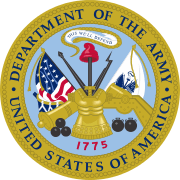Army of the United States
The Army of the United States (AUS) is the official name for the conscription (U.S. term: draft) force of the United States Army that may be raised at the discretion of the United States Congress when the United States enters into a major armed conflict. The Army of the United States was used in World War II, the Korean War, and the Vietnam War.
History
World War II
The Army of the United States (AUS) was established in February 1941, in response to the increasing threat of the United States entering World War II. The Army of the United States saw a major expansion following the December 1941 attack on Pearl Harbor. It was considered the successor to the National Army, which had been founded to fight in World War I and was disbanded in 1920.
The first commissioned officers of the Army of the United States were appointed from the Regular Army. The standard practice that these officers held a "permanent rank" within the Regular Army as well as a higher "temporary rank" while serving in the Army of the United States. A typical situation might be a colonel in the AUS holding the permanent rank of captain in the Regular Army. Another term for the AUS was "Theater Rank," held by officers deployed to the European Theater or serving in the Pacific.
Promotions within the Army of the United States were sometimes very rapid, and some officers were promoted as many as four to five times in the space of just three to four years. Dwight D. Eisenhower, who served as General of the Army, rose from a colonel to five-star general in three years. However, rank in the AUS could be revoked just as easily, with senior commanders who were relieved reverting to their permanent Regular Army rank. This was known as "loss of theater rank," with some instances of generals returning to the United States in disgrace or at least under a cloud, as only colonels or majors.
The enlisted force of the Army of the United States was made up of Regular Army professionals, but unlike their officer counterparts, they did not hold any AUS rank and were considered as Regular Army only. Personnel enlisting in the United States Army could also choose to enlist as Regular Army, which required a longer service obligation. The draft forces of the U.S. Army were all Army of the United States personnel and were annotated by the abbreviation "AUS" in front of their service numbers and in the Component block 5 on their discharge papers. Regular Army personnel were denoted by the abbreviations "RA."
In 1946, with postwar demobilization, the Army of the United States was suspended, along with the draft. Officers from that point reverted to Regular Army rank and all enlisted personnel either were discharged from the AUS or reenlisted in the Regular Army. The Army of the United States was reinstated during the Korean War, but it was mainly confined to the enlisted forces. Most commissioned officers in the Korean War held Regular Army rank only.
Korean War
On its reinstatement for the Korean War, the Army of the United States consisted of conscripts in the Regular Army, with the National Guard and Army of the United States existing simultaneously in the same theater. The system of Service Numbers was as follows:
- ER: Enlisted Reserve
- OR: Officer Reserve
- NG: National Guard
- RA: Regular Army
- US: Army of the United States
For the Korean War, the Army of the United States changed its abbreviation to "US," replacing the older "AUS."
Vietnam and beyond
The last use of the Army of the United States was during the Vietnam War. It was disbanded in 1974, one year after US forces withdrew from the Republic of Vietnam.
The Army Reserve and Army National Guard have never been incorporated into the Army of the United States, and have always been separate components. The Army National Guard is known by the service abbreviation "ARNG," while the Army Reserve is referred to as "USAR."
Notes
References
- "The Draft Force of the United States Army", (Yarborough, William P., Lieutenant General, RA), Self Published, 1973
- Commanding Generals and Chiefs of Staff, (Bell, William G.), Center of Military History, United States Army, 1997
- The Sergeants Major of the Army, (Gillespie, Mark F., Hawkins, Glen R., Kelly, Michael B, Pierce, Preston E.), Center of Military History, United States Army, 1995
- "Case Reference Guide for Review of Military Records", Military Personnel Records Center, published 2001
- "Army Force Components Training Guide", Military Personnel Records Center, published 2003
- United States Army Service Records (1910–2005), National Personnel Records Center, Overland, Missouri
- Article Two of the United States Constitution
